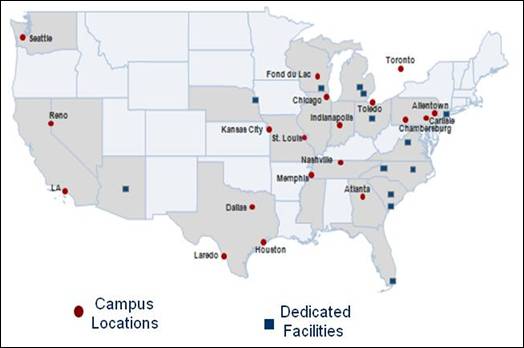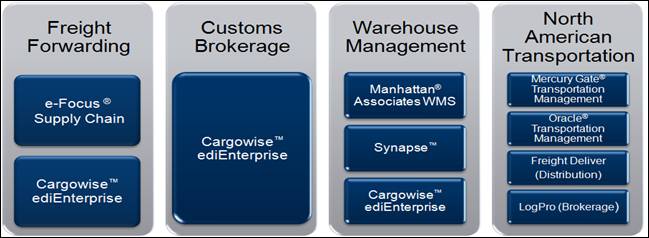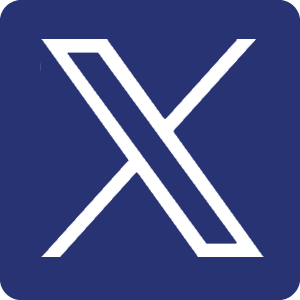OHL Leverages Transportation Management for Increases in Profitability and Growth
Brentwood, Tennessee USA Site Visit
December 20, 2011
By
Evan Armstrong
Key Personnel:
Scott McWilliams, Executive Chairman
Gregory Sanders, President – North American Transportation
Derek Fain, Senior Vice President of Business Development – North American Transportation
Robb Porter, Vice President & General Manager – North American Transportation
Joe Brunetti, Business Unit CFO – North American Transportation
Doug Frank, Vice President of Logistics Shared Services – North American Transportation
Jeff McDermott, Vice President – North American Transportation
Kara Brown, Communications Director
OHL Overview
Founded in 1951 as warehousing company Ozburn-Hessey Logistics, today’s rebranded OHL has completed multiple strategic acquisitions and grown organically to develop its current extensive global network and broad integrated service offering. It has over 32 million square feet of warehouse space, primarily in North America, and has greatly enhanced and expanded its domestic and international transportation management capabilities. OHL has over 7,000 employees who generated sales of $1.2 billion in 2010 from operations in 18 countries. Value-Added Warehousing and Distribution (VAWD) contributed $432 million of revenues in 2010, North American Transportation management (NAT) expanded to $316 million and Global Freight Management and Logistics (GFML) added $423 million. OHL is on track to finish 2011 with gross revenues of $1.4 billion.
OHL – U.S. Campus and Dedicated Warehousing Locations

OHL provides logistics solutions to several large companies including Arch Chemicals, Coca-Cola, Land O’Lakes, Red Bull, Samsung, and Starbucks. It is majority owned by private equity investment firm, Welsh, Carson, Anderson & Stowe, which has supported management changes over the last few years to reflect OHL’s push for globalization.
OHL’s global transportation management network includes 50 OHL owned offices and more than 250 agent partners worldwide. It has a significant Asia-Pacific, Europe, and North American footprint. OHL’s customs brokerage operation has a staff of 57 licensed customs brokers and 57 customs specialists who processed over 400,000 customs house brokerage entries in 2010. OHL has been ranked by the U.S. Customs and Border Protection Agency as the 11th largest (by entry volume) customs broker in the U.S. for the ranking period of July 2011-September 2011.
OHL – Global Transportation Management Systems
To support its operations, OHL has integrated multiple best-in-class supply chain and warehouse management systems. Its core systems “backbone” includes Cargowise for GFML, Manhattan’s warehouse management system (WMS) for VAWD, and MercuryGate and Oracle for NAT. The complete suite is detailed in the figure below.
OHL – Supply Chain Systems Suite

Focus on North American Transportation Management
While the OHL brand is most often associated with its warehousing operations, its NAT operations have been growing rapidly and have helped OHL improve its overall operating margins. NAT revenues grew 27% from 2009 to 2010 and are on pace to grow 33% from 2010 to 2011 expanding total gross revenues to $420 million. On a transportation management by mode basis, OHL is 44% truckload, 42% less-than-truckload (LTL), 5% parcel, 4% drayage, and the rest is intermodal.
OHL operationally divides its North American Transportation operations into three business units: 1. “TM” (transportation management), 2. “Brokerage” (freight brokerage/transactional freight management), and 3. “Distribution” (specialized, asset-based, temperature-controlled, LTL shipment management). TM is on track to grow 37% in 2011 to $235 million in gross revenue. OHL’s Brokerage operation is on track to finish 2011 at $130 million and contributes solidly to OHL’s overall profitability. The niche Distribution business will finish up 2011 with approximately $55 million in revenues. OHL’s five-year goal is to expand its NAT operations to $1 billion in gross revenue and double its combined NAT EBITDA (earnings before interest, tax, depreciation and amortization) margins.
OHL has recruited some transportation specialists to lead its North American Transportation business unit. Greg Sanders, president, and Doug Frank, vice president of logistics shared services, both spent time in senior roles at Schneider. Jeff McDermott, vice president of technology, and Derek Fain, senior vice president of business development, come from long transportation histories including YRC, Ryder and Penske. Joe Brunetti, NAT’s chief financial officer, spent time in a senior financial role in a fast growing transportation and carrier company. Robb Porter rounds out the management team with his experience in business development and operations at Ryder and Menlo.
2010 saw new strategic growth and investment for the Brokerage business unit with the opening of three new offices (Chicago, IL; Dallas, TX, and Sparks, NV) and multimodal expansion into intermodal and flatbed specialized services. It now has a staff of 140 in Gainesville, GA (previously Turbo Logistics which OHL acquired in 2006) and staff in Sparks, Dallas, and Chicago. The division is on target to open two additional offices in 2012. Brokerage uses a modern split business model with separate operations staff specializing in generating carrier capacity and inside sales personnel developing business and generating loads.
To meet growing Brokerage and TM customer needs, OHL has been actively developing and expanding its carrier base and qualifying an average of 15 carriers a day for the last 17 months. It uses a core carrier strategy which focuses on providing those carriers with the best service and pricing with the most shipments. OHL primarily utilizes regional carriers and spends a significant amount of resources managing its carrier relationships through ongoing executive contacts, quarterly business reviews, and service recognition programs.
OHL’s TM business unit supports customers with an operations staff of 70 located in its Brentwood, TN headquarters and Sparks, NV office. According to OHL, it can provide mid-tier customers with solutions only previously offered to much larger 3PL customers. For its mid-tier and large shippers, TM improves transportation management processes through enhanced inbound and outbound carrier routing compliance, improved carrier management, systematic shipment consolidation and mode selection, automated transportation management execution, post shipment support, and better business intelligence and reporting to support process improvements and transportation management.
For 2012, TM is simplifying its IT platform and will have all of its customers on one of two transportation management systems (TMS); Oracle’s OTM software and MercuryGate’s TMS. In our opinion, both systems are tier-one TMS with very good transportation planning and execution capabilities. For network modeling and TM solutions development, OHL’s six-person engineering team is using JDA/i2’s Transportation Modeler and MercuryGate’s Mojo applications. It also uses IBM’s LogicNet software for network supply chain modeling.
To detail potential savings for its TM customers, OHL uses a targeted “Value Grid” approach. OHL works with its customers in defining the specific business process improvement areas.
The following case studies provide specific examples of how OHL works with its transportation management customers to make process improvements and reduce costs.
Seventh Generation TM Customer Case Study
Established in 1988, privately-held Burlington, Vermont based Seventh Generation is committed to selling household and personal care products which protect human health and the environment. Its business has been expanding with increased order volumes to its large retail customer base. Its growth caused Seventh Generation to look at options to support increased supply chain demands.
Seventh Generation’s previous transportation management solution did not provide the requisite technology needed for optimal transportation planning capabilities, visibility, and reporting to manage its business. In 2009, OHL was selected to perform a supply chain network modeling study for Seventh Generation to identify potential areas for warehousing and transportation improvements. After identifying significant benefits through improved transportation management, OHL was tapped to make improvements in Seventh Generation’s order planning process and reduce transportation costs via systematic transportation optimization.
OHL implemented a TMS for daily shipment planning and transportation optimization. The TMS was also leveraged to ensure retailer purchase order delivery windows were made in order to prevent fines and chargebacks. After a successful first phase, in the second phase of the project, OHL implemented an inbound vendor management program using a TMS to drive carrier compliance and proper mode selection.
To date, OHL’s TM division is annually managing approximately 3,000 inbound and outbound shipments for Seventh Generation. The percent of shipments by direction and mode are as follows:
- Outbound LTL 71.4%
- Outbound TL 28.6%
- Inbound TL 82.9%
- Inbound Intermodal 15.7%
- Inbound LTL 1.3%
Reports and data provided by OHL drove improved supply chain management and visibility for Seventh Generation. These included:
- Improved inbound shipment visibility and advance shipment notifications enabled better dock planning and operational efficiencies at Seventh Generation’s warehousing operations.
- Outbound orders are better planned based upon inbound receipts.
- Monthly financial reporting from OHL’s TMS resulted in better accrual reporting to track and manage transportation expenses.
- Data and modeling tools monitor Seventh Generation’s total carbon footprint.
As Seventh Generation’s business has grown, OHL has utilized the TMS data and its network modeling tools to ensure that the current distribution network is still achieving optimal results. OHL currently has multiple continuous improvement projects underway to achieve additional savings by leveraging its TMS functionality in reviewing potential pool points and building continuous truckload moves.
Nissan Forklift TM Customer Case Study
Nissan Forklift is a wholly owned subsidiary of Nissan Motor Co. Ltd. It manufactures forklifts and pallet jacks at its plant in Marengo, IL.
Nissan Forklift has outbound shipments to approximately 200 dealers and engine users. It was suffering from a lack of outbound transportation planning, had no TMS, and was using a manual carrier routing guide. Additionally, Nissan lacked shipment visibility for both inbound and outbound shipments.
In 2009, OHL’s TM group was selected to manage Nissan’s outbound transportation and provide a TMS solution to improve shipment visibility and support key performance indication (KPI) service metric reporting. OHL leveraged relationships with its truckload carriers who were capable of supporting multi-stop truckload moves and deployed its Oracle TMS for daily transportation management. The TMS is utilized by OHL TM’s onsite operation of two dedicated transportation professionals to manage all transportation operations. The team is also using OHL’s WMS to manage Nissan’s warehouse labor. Approximately 12,000 outbound shipments are planned and optimized by the two person team annually.
In terms of results, OHL developed a monthly savings report used to “re-baseline” Nissan’s transportation business and negotiate with carriers. Through its work with OHL, Nissan Forklift initially saved 7% overall on LTL and truckload transportation and continues to drive savings and efficiencies year-over-year. Nissan Forklift also has on-demand access to data and OHL engineering expertise. Working with Nissan, OHL helped develop a “Dealer Cost Matrix” which was used to support a cost increase to Nissan’s customers and facilitated needed increases in labor charges per unit.
OHL Operations Summary
OHL is no longer just a warehousing company. It has grown strategically and is now an integrated 3PL with expanding domestic and international transportation management capabilities. Its capabilities and increasing global scope have made it a go-to provider for large companies such as Starbucks. With rapidly expanding domestic transportation management operations, we anticipate OHL will be successful in continuing to land more integrated supply chain management business and work with transportation management customers, such as Seventh Generation and Nissan Forklift, who need solid solutions.
Sources: A&A Primary Research, https://geodis.com/us


